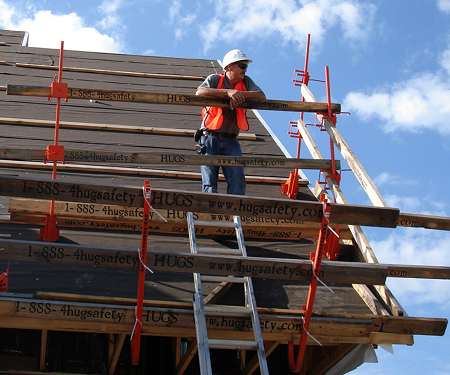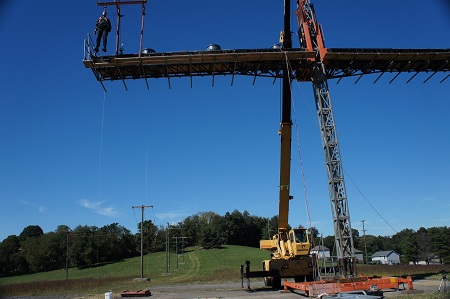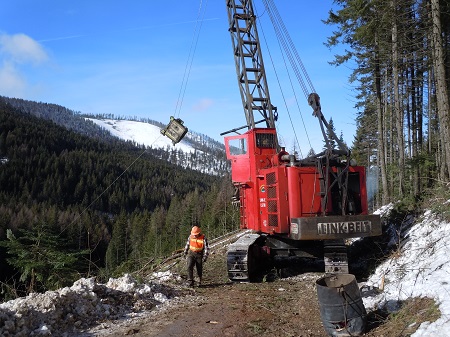Research Rounds – Volume 3, Issue 10, April 2018
NIOSH Research Rounds is a monthly bulletin of selected research conducted by researchers at NIOSH and NIOSH-funded researchers at other institutions.
Volume 3, Number 10 (April 2018)
Inside NIOSH:
Falls Persistent Cause of Work-related Death

Falls remain a persistent cause of work-related death, and workers in construction and oil and gas extraction are more likely than other workers to die from falling, according to NIOSH research published in the American Journal of Industrial Medicine.
Investigators analyzed fatal falls using records from the Bureau of Labor Statistics (BLS) Census of Fatal Occupational Injuries. To estimate the rates of fatal falls in different occupations and groups of workers, they used population estimates from the BLS Current Population Survey. They identified 8,880 worker deaths from falls at work from 2003 to 2014. Most of these falls occurred in construction and oil and gas extraction when a worker fell from a higher to a lower level, rather than from falls on the same level. Most of the deaths were among men, who died from work-related falls more than 4 times as often as women. In addition, older workers were more likely to die from a fall at work than younger workers were. The highest death rate was among workers age 65 and older, although the majority of the fatal falls were among 45 to 54 year olds. The study also found differences by place of birth and race. Workers born in another country had a higher rate of fatal falls to a lower level. The highest rate of fatal falls occurred among Hispanic workers compared to white (non-Hispanic) workers.
These findings highlight the importance of collaboration to prevent work-related falls through compliance with safety regulations, prevention through design to create safe workplaces, and worker training. With the goal of prevention, NIOSH and its partners relaunched the National Safety Stand-Down to Prevent Falls in Construction this month, and NIOSH investigators continue to study where and how falls occur.
More information is available:
- Fatal Work-related Falls in the United States, 2003-2014
- National Safety Stand-Down to Prevent Falls in Construction
- NIOSH: Falls in the Workplace
- NIOSH: Construction Safety and Health
- NIOSH: Research and Practice for Fall Injury Control in the Workplace: Proceedings of International Conference on Fall Prevention and Protection (Overview of NIOSH-designed Guardrail System)
- John Howard, M.D., Director
- Christina Spring, Editor in Chief
- Anne Blank, Story Editor
- Jeanette Novakovich, Copy Editor
- Glenn Doyle, Technical Lead
- Tonya White, Technical Support
Obesity, Physical Inactivity, or Short Sleep Affect 1 in 5 Workers
Short sleep, obesity, and physical inactivity occur frequently among workers, affecting more than one in five, according to a recent NIOSH study published in the Journal of Occupational and Environmental Medicine.
These modifiable risk factors can lead to serious illnesses, such as heart disease and type 2 diabetes. Furthermore, obesity and physical inactivity negatively affect the U.S. economy, with annual healthcare costs estimated at $147 billion for obesity and $117 billion for inadequate physical activity. Evidence suggests that workplace factors such as working long hours and shift work may increase the likelihood of short sleep, obesity, and physical inactivity.
NIOSH investigators compared the prevalence of these risk factors across occupations by examining survey responses from the 2013-2014 Behavioral Risk Factor Surveillance System (BRFSS). BRFSS is an anonymous, phone-based survey of health and related behaviors among U.S. adults. The Centers for Disease Control and Prevention (CDC) collaborates with all 50 states, the District of Columbia, and 3 U.S. territories to conduct the BRFSS annually. The study sample included non-military adult workers from 22 occupational groups who worked in one of the 29 states that collected occupational data.
The most common problem found was short sleep, with one in three workers averaging fewer than 7 hours of sleep per night. Next was obesity, with one in four workers having a body mass index (BMI) of 30 or higher. The third was physical inactivity, with one in five workers reporting not engaging in any leisure-time physical activity in the past month.
Significant differences occurred between occupations, even after controlling for sex, race and ethnicity, age, and education. One occupational group—transportation and material moving—had significantly higher prevalence of all three risk factors among both men and women when compared to all workers. Furthermore, among women, food preparation and serving occupations had significantly higher prevalence for both no leisure-time physical activity and short sleep. Among men, those employed in protective services had a significantly higher prevalence of both obesity and short sleep. Three additional occupational groups had significantly greater prevalence of short sleep compared to all workers: production, health care support, and health care and technical services.
The pervasiveness of short sleep, obesity, and physical inactivity among workers highlights the need for additional research to identify and control workplace factors that contribute to these serious health risks.
More information is available:
- Prevalence of Obesity, No Leisure-time Physical Activity, and Short Sleep Duration Among Occupational Groups in 29 States
- Behavioral Risk Factor Surveillance System
Freestanding Mast-climbing Work Platform Remains Stable During Fall Arrest, If Properly Used

If you have seen a construction site recently, you may have noticed workers standing on elevated equipment that resembles scaffolding, except with only one platform level for workers. With its ship-like mast, this equipment is aptly called a mast-climbing work platform, or mast climber for short.
Unlike traditional scaffolding anchored on the side of a building or other structure, mast climbers can be either anchored or freestanding. They offer several advantages over traditional scaffolding, including the ability to reach greater heights, hold heavier loads, and configure form to fit a particular work site. These advantages have led to wider use of mast climbers throughout the construction industry, even as their potential safety risks to workers remain unclear. At NIOSH, engineers study these risks and the best ways to prevent them.
Of particular concern is the mast climber’s stability during a fall event. To prevent falls, the Occupational Safety and Health Administration requires mast climbers and other types of scaffolding to have guardrails or personal fall-arrest systems. Personal fall-arrest systems comprise a wearable harness anchored to the mast climber to stop a worker from falling.
NIOSH engineers recently tested the stability of a freestanding mast climber in different scenarios. These scenarios tested fall arrest with a life-size dummy wearing a personal fall-arrest system under differing configurations of platform load. Their findings, published in the Journal of Safety Research, showed that when properly assembled according to manufacturer’s instructions the mast climber remained stable and upright. At the same time, however, the results showed that workers near an open edge without a personal fall-arrest system could be injured when another worker on the platform has a fall arrest incident. According to the engineers, these workers also should wear personal fall-arrest systems when near open edges on the platform to protect them from being shaken or knocked off the mast climber during a fall incident. Further research is necessary to understand other potential safety risks of mast climbers, according to the engineers.
More information is available:
- Evaluating the Stability of a Freestanding Mast Climbing Work Platform
- NIOSH: Falls in the Workplace
Outside NIOSH:
Global Navigation Satellite Systems Aid Communication, Awareness in Logging

With the first satellite launch in the late 70s, the U.S. global positioning system (GPS) expanded our technological boundaries. Today’s global navigation satellite systems (GNSS) include GPS and newer, similar systems that transmit location and time information from satellites in space to receivers on Earth.
This technology can help protect workers across many industries, including farming, construction, mining, and logging. Each industry, however, presents unique challenges to the safe use of GNSS. For example, trees and other land features, or topography, on logging sites potentially can interfere with satellite signals, and lack of cellular or WIFI networks often hampers our ability to share data in remote areas.
At the University of Idaho, NIOSH-funded investigators explore the effects of interferences on the accuracy of alerts triggered by GNSS-based geofences. The investigators tested geofence alerts across different types of forest conditions in the University of Idaho’s experimental forest. In their study published in the journal PLOS One, the researchers reported that alert accuracy or missed signals varied depending upon tree density and other aspects of topography, such as the proximity of hills, valleys streams, and roads. Since these factors differ significantly on actual logging worksites—sometimes even within one worksite—these results indicate that GNSS technology can help improve communication and general situational awareness at the worksite. However, due to the occurrence of inaccurate alerts or missed signals, the investigators cautioned against relying upon geofences that define safe work zones.
These findings confirm two previous studies by the same team, showing that a mobile geofence could help increase workers’ situational awareness of their worksite in logging and other occupations. Together, findings from all three studies highlight the importance of further research to improve the accuracy of GNSS alerts across different types of forest terrain and for different workplace hazard scenarios that occur in forestry.
The NIOSH Expanding Research Partnerships Webinar Series will feature this research during its May 2018 presentations.
More information is available:
- Real-time Positioning in Logging: Effects of Forest Stand Characteristics, Topography, and Line-of-Sight Obstructions on GNSS-RF Transponder Accuracy and Radio Signal Propagation
- Characterizing Rigging Crew Proximity to Hazards on Cable Logging Operations Using GNSS-RF: Effect of GNSS Positioning Error on Worker Safety Status
- Hazards in Motion: Development of Mobile Geofences for Use in Logging Safety
- NIOSH Research Rounds: Mobile Geofence Can Help Monitor Work Surroundings
- NIOSH: Extramural Research and Training Programs
- University of Idaho Experimental Forest
Mention of any company or product does not constitute endorsement by NIOSH.
